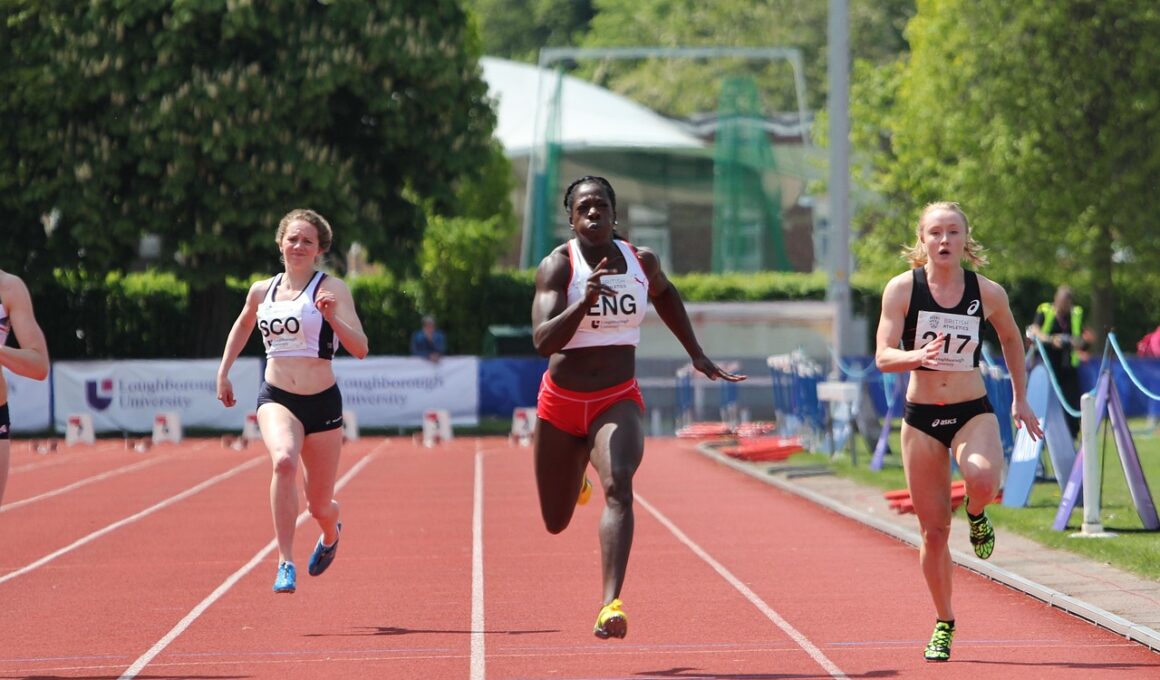Periodization Strategies for Peak Performance in Athletes
To enhance athletic performance, a systematic approach called periodization is essential. This method involves structuring training cycles to optimize the athlete’s adaptation, ensuring they peak at the right moment. Periodization aligns training loads with competition schedules, enabling athletes to improve strength, speed, and endurance progressively. Coaches often implement various models of periodization, including linear, undulating, and block periodization. Each model focuses on different aspects of training, allowing for tailored programs based on the athlete’s specific needs and goals. For successful implementation, coaches must consider various factors, such as the sport’s demands, the athlete’s current state, and recovery protocols. Establishing a baseline fitness level is crucial to gauge improvements over time. Trainers can monitor progress through tests, feedback, and performance analytics. Additionally, integrating physiological metrics helps to adjust training loads when necessary. Finally, communication between athletes and coaches is vital, as it promotes commitment and accountability. Effective periodization not only prevents injuries but also enhances performance, ensuring athletes consistently deliver their best on competition day. By prioritizing recovery and adaptation phases, athletes can realize their full potential in their respective disciplines.
Another significant aspect of periodization is the concept of macrocycles, mesocycles, and microcycles. These cycles categorize training into various lengths, helping to organize and structure workouts effectively. A macrocycle typically spans a year, encompassing all training phases leading up to major competitions. Each macrocycle contains several mesocycles, which usually last from several weeks to a few months, focusing on specific objectives such as strength, endurance, or skill refinement. Within each mesocycle, multiple microcycles often represent one-week training blocks. Each block targets specific adaptations, allowing athletes to focus on minute details in their training. Coaches often rotate through these cycles, adjusting intensity and volume based on the athlete’s condition and competition schedule. This systematic approach promotes targeted improvements over the training year, ensuring athletes continuously progress towards peak performance. Moreover, varying training stimuli within and among cycles prevents monotony, which can lead to burnout or plateauing. Additionally, it allows for recovery periods that help in injury management and overall well-being. When coaches comprehend the interrelation of these cycles, they can develop more effective training programs tailored to individual athletes’ needs in their respective sports.
Importance of Recovery in Periodization
Recovery is an integral part of any effective periodization strategy. Overtraining can significantly hinder an athlete’s performance and lead to injuries if not managed appropriately. This is why designated recovery periods should be incorporated into the training cycles. Recovery allows the body to repair and adapt to the physical demands of training, meaning coaches must prioritize these phases in their planning. Scheduling active recovery sessions, like light workouts or cross-training, can effectively reduce fatigue and maintain fitness levels without overexertion. Additionally, proper nutrition and hydration support recovery, ensuring athletes refuel their bodies after training. Utilizing techniques like stretching, foam rolling, and massage also aids in mitigating soreness and muscle tightness. Coaches and sports scientists often recommend implementing deload weeks, where intensity and volume are significantly decreased, allowing the body to recuperate fully. This strategy enables athletes to return to training rejuvenated and ready to tackle new challenges. Additionally, monitoring psychological fatigue is crucial, as mental recovery impacts physical performance. By equipping athletes with the tools they need to recover properly, coaches can enhance performance while minimizing the risk of injuries.
Moreover, variety in training is crucial for both physical and mental engagement in athletes. Periodization allows for continual adjustments to training regimens, which can keep athletes motivated and interested in their workouts. Changing up exercises, training locations, and methodologies helps prevent the boredom that can lead to a decrease in performance. Coupled with strategic implementation of different training modalities, this variety ensures the athlete develops all necessary physical attributes required for their sport. Incorporating various strength training methods, such as Olympic lifts, resistance training, or circuit training, allows for cross-training benefits. Additionally, blending cardiovascular workouts with skill drills ensures that athletes maintain sport-specific competencies while improving their overall fitness level. Maintaining a balance between sport technique and broader athletic development remains essential. By approaching training with this multifaceted mindset, coaches can facilitate meaningful growth in their athletes. Furthermore, it cultivates a culture of adaptability within training programs, preparing athletes for varied challenges in competition and fostering resilience. A diverse and engaging training environment can lead to heightened performance outcomes.
Implementing Technology in Periodization
Advancements in technology have transformed how coaches approach periodization, offering tools to enhance tracking and evaluation. Wearable technology, such as heart rate monitors and GPS trackers, provides real-time data on athletes’ performance and recovery metrics. Coaches can analyze training loads, understand fatigue levels, and decide when athletes need more recovery or intensified sessions. Software and applications dedicated to performance analysis also support coaches in designing individualized training plans. Coaches can sift through historical data to identify patterns, anticipate athletes’ needs, and modify training protocols accordingly. Furthermore, implementing athlete management systems streamlines communication and progress tracking, ensuring that all team members are aligned with the plan. These digital tools enhance collaboration between athletes and coaches, as both parties can review performance analytics to identify strengths and weaknesses. Video analysis is another useful method, allowing athletes to visually assess their techniques and make adjustments based on targeted feedback. While technology should support, not supplant the traditional coaching process, it can significantly improve data-driven decision-making. Embracing technology within periodization enhances the overall training experience and leads to more significant performance gains for athletes trying to achieve peak excellence.
As consistency remains a vital element of effective periodization, maintaining a comprehensive training log can significantly benefit athletes. Recording workouts, nutrition, and recovery practices fosters a sense of accountability and can help athletes notice patterns concerning their performance. This tool provides insights into what training techniques or recovery strategies yield optimal results, allowing for informed adjustments. Additionally, understanding specific responses to different training stimuli enables athletes to personalize their approach and push through performance plateaus. Coaches can use these logs to determine when to alter the periodization plan and recommend focused interventions. Through the diligent use of this tool, both athletes and coaches can engage in a continuous dialogue regarding adaptations, facilitating a proactive approach to training management. Moreover, analyzing training logs collectively can build a strong coach-athlete relationship, where athletes feel empowered and respected. Coaches embracing this collaborative atmosphere enhance motivation and commitment levels in their athletes. Furthermore, emphasizing consistency through training logs underscores the importance of perseverance and dedication, vital traits that contribute to an athlete’s long-term success in any sport.
Conclusion: Maximizing Athletic Performance
To conclude, effective periodization strategies are crucial for athletes aiming to maximize their performance. By meticulously planning training cycles with built-in recovery, monitoring progress with technology, and maintaining open communication, coaches can significantly enhance their athletes’ performance capacities. Periodization offers a comprehensive framework that allows athletes to adapt, recover, and peak strategically. Coaches must remain adaptable and attentive to emerging trends in sports science, continuously evolving their methodologies to incorporate new best practices. Athletes, on their part, should be encouraged to take an active role in their training journey, utilizing resources like training logs and technology to establish ownership over their growth. Ultimately, striking the right balance between intensity, volume, and recovery is paramount in ensuring long-term success. Effectively applying periodization techniques teaches commitment, discipline, and resilience, allowing athletes to reach outstanding levels of performance. By embracing these principles, coaches can foster an environment where athletes flourish and achieve their dreams. Periodization is more than a scheduling tool; it’s a philosophy that encompasses the entire athlete training experience to enable sustained excellence in sports.
The integration of periodization principles not only enhances individual athlete performance but can also uplift team dynamics. When coaches structure training effectively across an entire team, they create an environment where every athlete peaks at the same advantageous time. This synchronized approach can significantly bolster team performance during competitive events. Furthermore, engaging athletes in understanding the rationale behind their training fosters trust and enhances their commitment to the process. Coaches should aim to empower their teams by sharing insights on how particular exercises or phases of training directly correlate with competition readiness. This transparency can breed a culture of collective responsibility, where athletes motivate each other to adhere to training protocols and support each other’s progress. The implementation of team-wide training logs can also optimize accountability and enable teams to celebrate milestones and achievements collectively. Communication between athletes and coaches regarding individual goals within the team’s framework is key. By harnessing the strengths of each athlete while fostering unity, coaches can prevail in encouraging an ethos of collaboration. In doing so, they set the stage for exceptional performances that can resonate throughout competitions, thus leaving a lasting impact on their legacy.


